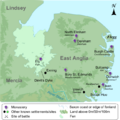Aethelthryth facts for kids
Quick facts for kids Saint Aethelthryth (Etheldreda) |
|
|---|---|

Saint Aethelthryth (Etheldreda)
|
|
| Born | c. 636 Exning, Suffolk |
| Died | June 23, 679 Ely, Cambridgeshire |
| Venerated in | Roman Catholic Church; Anglican Communion; Eastern Orthodoxy |
| Major shrine | St Etheldreda's Church, Ely Place, Holborn, London; Originally Ely Cathedral (now destroyed) |
| Feast | June 23 |
| Patronage | Throat complaints |
Saint Aethelthryth (also known as Etheldreda) was an important Anglo-Saxon saint. She was born around 636 and died on June 23, 679. Aethelthryth was also a princess from East Anglia and later became the leader (Abbess) of a famous monastery in Ely.
Her Life Story
Aethelthryth was born in East Anglia, which is now part of Suffolk, England. She was one of four daughters of King Anna of East Anglia. All of her sisters also became nuns and started their own monasteries.
From a young age, Aethelthryth wanted to dedicate her life to the Church. She made a special promise to remain a virgin. When a nobleman named Tondberht of the South Gyrwas asked to marry her, her parents agreed. Aethelthryth did not want to marry, but she kept her promise to stay a virgin even after marriage. When Tondberht died in 655, she moved to the Isle of Ely. Her husband had given her this land as a gift.
Aethelthryth later married Ecgfrith of Northumbria in 660. Ecgfrith was the son of King Oswiu of Northumbria. After Ecgfrith became king, Aethelthryth asked him if she could become a nun. She was encouraged by Bishop Wilfrid to continue her religious life. This caused some disagreements between Ecgfrith and Bishop Wilfrid.
One story says that Ecgfrith first agreed that Aethelthryth could remain a virgin. But around 672, he changed his mind because he wanted to have children to be his heir. He tried to offer Bishop Wilfrid gifts to convince Aethelthryth to change her mind. This did not work. The king then tried to take his queen from her convent.
Aethelthryth fled back to Ely with two nuns. She managed to escape capture. A legend says that she got away because the tide miraculously rose, blocking her pursuers. Another version of the legend says she stopped her journey at a place called 'Stow'. She hid under an ash tree that suddenly grew from her staff after she planted it in the ground. This place later became known as 'St Aethelthryth's Stow'. A church was built there to remember this event. Stow Minster still has a stained glass window showing this legend.
Ecgfrith later married another woman named Eormenburg. He also sent Bishop Wilfrid away from his kingdom in 678. According to the Anglo-Saxon Chronicle, Aethelthryth founded a special monastery at Ely in 673. This monastery was later destroyed during the Danish invasion in 870. Aethelthryth lived at Ely for the rest of her life, devoted to her faith. She died from the plague. A hymn was written in her honor.
Aethelthryth's niece and her great-niece, who were also princesses, became the leaders (abbesses) of Ely after her.
Bede and a book called The Liber Eliensis describe what happened in 695. Aethelthryth's sister, Seaxburth, had her body dug up. This was done to move her from a simple grave to the new church at Ely. Aethelthryth had been dead for sixteen years. When her body was brought out, it was said to look just as it did when she was alive. She was reburied in a white, marble coffin. People believed that Aethelthryth's body and clothes, which had not decayed, had miraculous powers. A burial chamber made of white marble was taken from old Roman ruins. It fit Aethelthryth perfectly. Seaxburh made sure her sister's body was washed and wrapped in new robes before being reburied.
St Etheldreda's Church
St Etheldreda's Church is a church dedicated to Saint Aethelthryth. It was once part of the palace where the Bishops of Ely lived. Later, the palace was used by Spanish Ambassadors, which allowed Roman Catholic worship to continue in the church. Today, it is a Roman Catholic parish church in Ely, Cambridgeshire. It holds the shrine and some holy items (relics) of Aethelthryth.
Images for kids
-
Site of shrine in Ely Cathedral
-
The kingdom of East Anglia (Early Saxon period)
See also
 In Spanish: Eteldreda de Ely para niños
In Spanish: Eteldreda de Ely para niños



